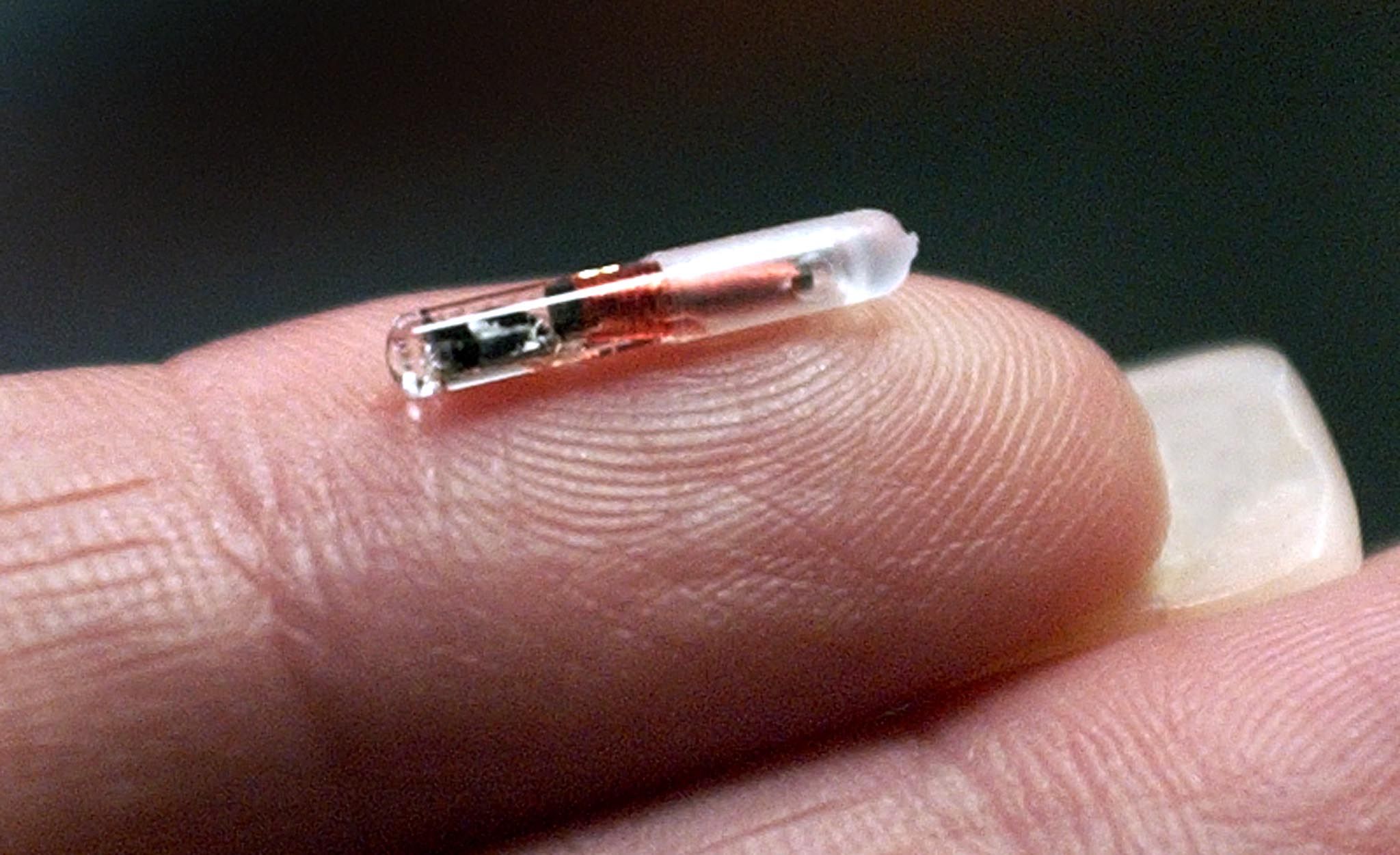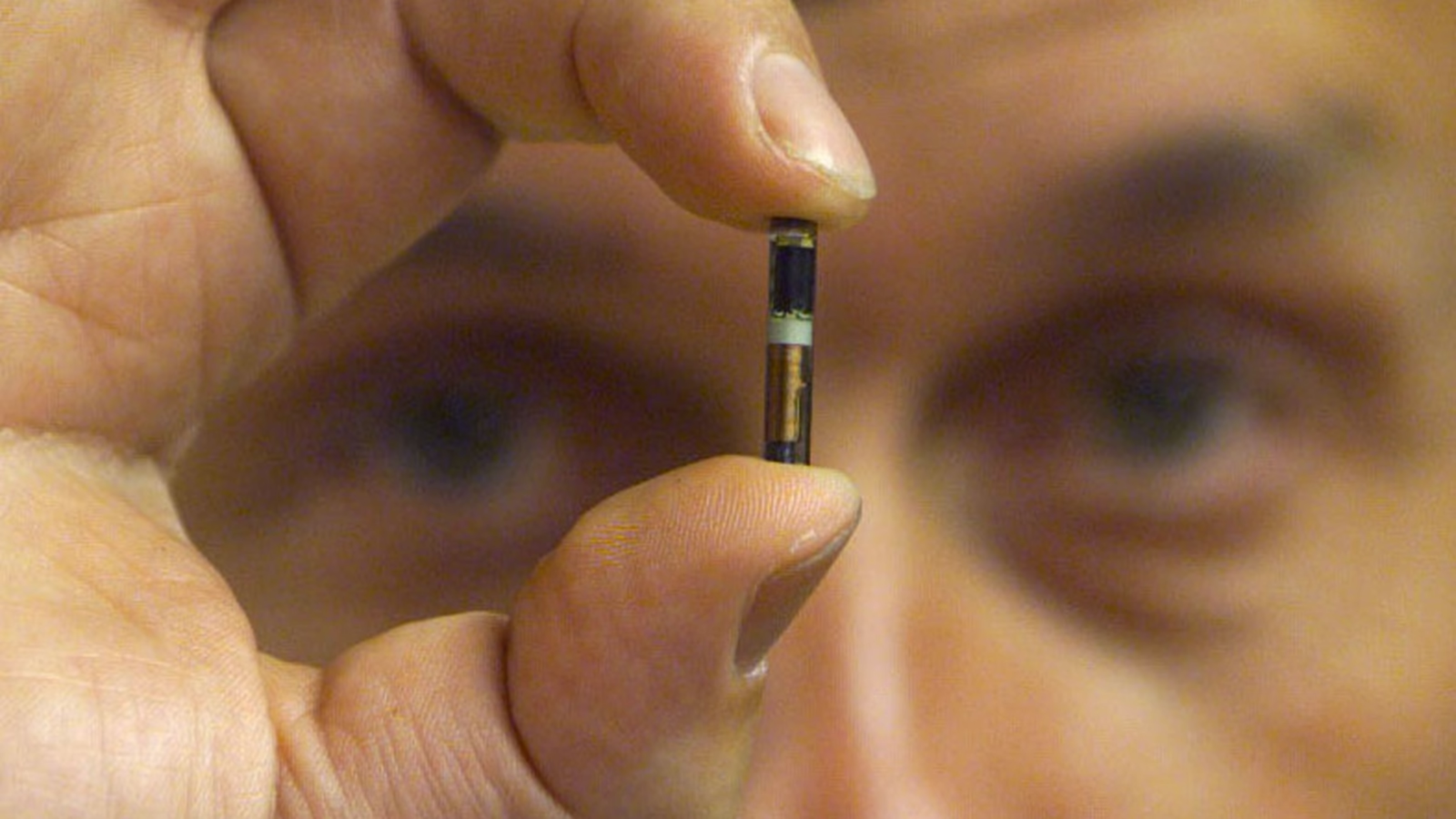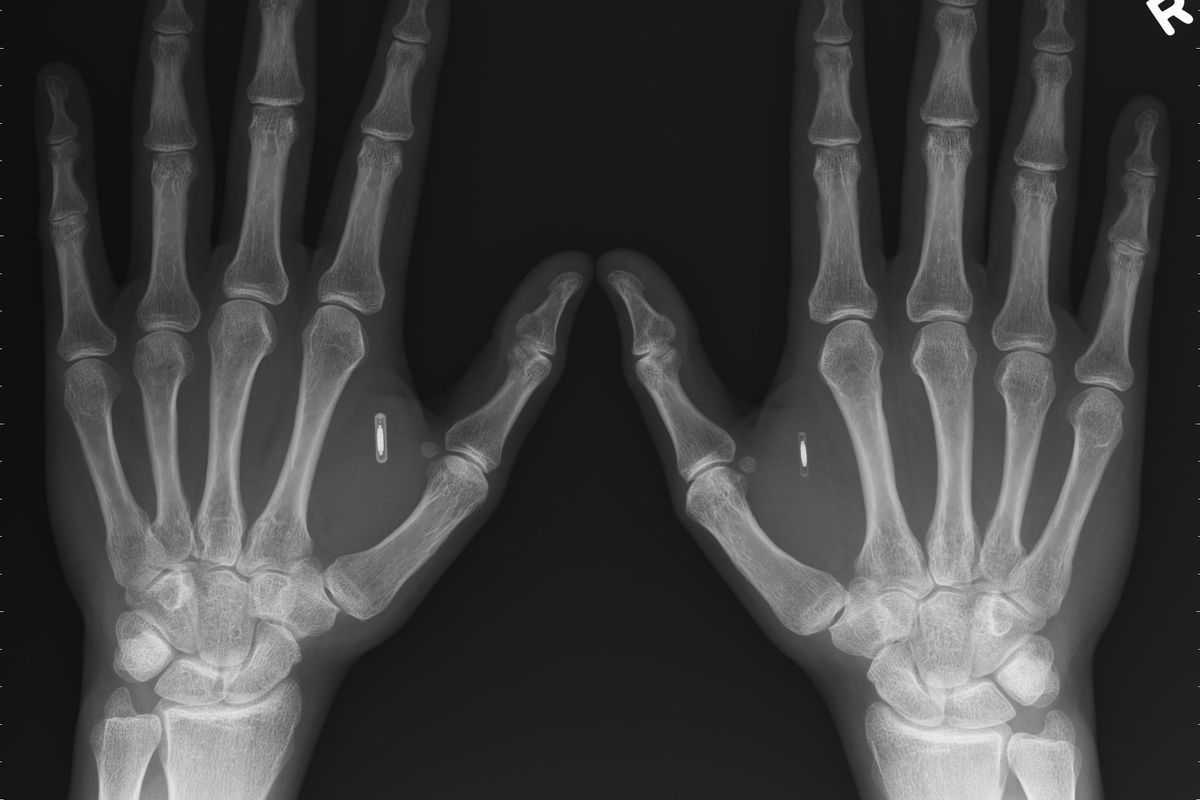What Is an RFID Chip
An RFID (Radio Frequency Identification) chip is a small device that uses radio waves to transmit data wirelessly. It consists of a microchip and an antenna, encapsulated in a tiny package. These chips are often embedded in various items, such as cards, tags, labels, or even implanted in living beings. The purpose of an RFID chip is to store and transmit information, making it a crucial component of RFID technology.
RFID technology has revolutionized the way objects are identified, tracked, and managed. Unlike barcodes that require line-of-sight scanning, RFID chips can be read from a distance, without the need for direct visibility. This feature enables fast and efficient data capture, improving inventory management, asset tracking, and access control systems.
The operation of an RFID chip is quite simple. When an RFID reader emits radio waves, the chip’s antenna receives the signal, powering the microchip and enabling it to transmit the stored information. This information can include unique identifiers, product details, or other relevant data depending on the application.
RFID chips are composed of various components, including the microchip, which processes and stores data, and the antenna, which enables communication with the RFID reader. Additionally, there may be other components such as a power source or memory storage, depending on the specific chip design.
There are different types of RFID chips available. Some are passive, meaning they do not have their power source and rely on the reader’s energy to operate. Others are active, possessing their power supply, making them capable of longer-range communication. Each type has its advantages and is suitable for different applications.
The applications of RFID technology are vast and varied. They can be found in industries like retail, transportation, healthcare, and logistics. RFID chips are used for inventory management, theft prevention, animal tracking, contactless payment systems, and even tracking medical equipment in hospitals.
The benefits of RFID technology are numerous. It enables improved efficiency and accuracy in inventory management, reduces costs by automating processes, enhances security and asset tracking, and streamlines operations. It also enables seamless and convenient customer experiences, such as contactless payments and personalized services.
However, the use of RFID chips raises concerns about privacy and security. As RFID technology allows for remote scanning, there have been apprehensions about unauthorized data access and tracking individuals without their consent. Privacy measures and encryption protocols are essential to address these concerns and protect sensitive information.
It is important to debunk some common misconceptions about RFID chips. Contrary to popular belief, RFID chips cannot track individuals’ location in real-time, as they only transmit data when activated by an RFID reader. Additionally, the range of communication is typically limited, ensuring that readers in close proximity are required for scanning.
The future of RFID technology looks promising. As it continues to advance, we can expect even more innovative applications and improved capabilities. The integration of RFID technology with other systems, such as artificial intelligence and the Internet of Things (IoT), will further enhance its potential in various industries.
Understanding RFID Technology
RFID (Radio Frequency Identification) technology is a method of identifying and tracking objects using radio waves. It works by utilizing RFID tags or labels attached to items, which can be read by RFID readers or scanners. This technology has gained widespread adoption in various industries for its ability to improve efficiency and accuracy in data capture and management.
At the heart of RFID technology are RFID tags. These tags are small devices that contain an RFID chip and an antenna. The chip stores information and the antenna enables communication with RFID readers. There are two main types of RFID tags: passive and active.
Passive RFID tags do not have their power source and rely on the energy emitted by the RFID reader for operation. When the reader sends out radio waves, the tag’s antenna captures the energy and uses it to power the chip, which then transmits its stored information back to the reader. Passive tags are cost-effective and suitable for short-range applications.
Active RFID tags, on the other hand, have their power source and emit a signal continuously. They can communicate with RFID readers over longer distances. Active tags are commonly used for tracking high-value assets, managing logistics, and monitoring real-time positions of items or vehicles.
RFID readers are devices that emit radio waves and capture the information transmitted by RFID tags. They can be handheld or fixed in a particular location. When a reader sends out radio waves, it energizes nearby tags, allowing them to transmit their data back to the reader. The reader then processes the information and sends it to a central computer system for further analysis or action.
Another critical component of RFID technology is the middleware. This software acts as a bridge between the RFID infrastructure and the back-end systems. It manages and filters the raw data from RFID readers, converts it into a usable format, and integrates it with existing business systems or databases.
RFID technology offers numerous benefits in various applications. In retail, it enables streamlined inventory management, ensuring accurate stock levels and reducing out-of-stock situations. In supply chain and logistics, RFID technology enhances traceability and enables real-time tracking of products, leading to improved efficiency and reduced errors.
RFID technology is also widely used in access control and security systems. RFID cards or badges are used to grant authorized individuals entry to restricted areas. The data stored on the RFID tags can be easily updated or disabled, offering a higher level of security compared to traditional key-based systems.
Overall, understanding RFID technology is essential for businesses and industries looking to improve their operations and enhance their data management capabilities. By harnessing the power of radio waves and RFID tags, organizations can optimize processes, reduce costs, and deliver better customer experiences.
How RFID Chips Work
RFID (Radio Frequency Identification) chips are at the core of RFID technology, enabling the identification and tracking of objects. These small devices consist of a microchip and an antenna, typically enclosed in a protective material. Understanding how RFID chips work is key to grasping the functionality of the entire RFID system.
RFID chips operate based on the principle of radio waves. When an RFID reader emits radio waves, the antenna on the chip captures the waves, converting them into electrical energy. This energy powers the microchip, allowing it to perform various functions, including storing and transmitting data.
The microchip in an RFID chip is responsible for processing and storing information. It contains a unique identifier, often referred to as the Electronic Product Code (EPC), which distinguishes one item from another. Additional data, such as product details or inventory information, can also be programmed into the chip.
Once the RFID chip is powered by the reader’s radio waves, it transmits its stored data back to the reader through the antenna. The transmission occurs through modulation of the radio waves, which represents the binary code of the stored information. The reader receives this transmission and decodes the data, making it available for further processing or integration with other systems.
The communication between the RFID chip and the reader occurs wirelessly and in real-time, making RFID technology highly efficient for data capture and management. Unlike traditional barcode scanning, which requires line-of-sight and individual scanning, RFID chips can be read simultaneously and without direct visibility.
RFID chips can be categorized into two main types: passive and active. Passive RFID chips rely on the power provided by the reader for operation. When the reader emits radio waves, the chip’s antenna captures the energy and uses it to power the microchip and transmit data. Passive chips are cost-effective, have a smaller form factor, and are widely used for various applications.
Active RFID chips, in contrast, have their power source, such as a battery, allowing them to emit a signal continuously. This enables longer-range communication between the chip and the reader. Active chips are commonly used for tracking high-value assets and applications that require real-time tracking or monitoring.
In addition to the microchip and antenna, RFID chips may also have other components depending on the specific design. Some chips may include additional memory storage, allowing for more extensive data storage, while others may incorporate cryptographic features to enhance security.
Overall, RFID chips play a pivotal role in the functioning of RFID technology. Their ability to store and transmit data wirelessly through radio waves enables the seamless identification and tracking of objects. Understanding how RFID chips work provides insights into the efficiency and potential applications of RFID technology across various industries.
Components of an RFID System
An RFID (Radio Frequency Identification) system consists of several components working together seamlessly to enable the identification and tracking of objects. Each component plays a vital role in the overall functionality and efficiency of the RFID system. Understanding the key components of an RFID system is essential for businesses and organizations looking to implement this technology.
1. RFID Tags: RFID tags are small devices that contain an RFID chip and an antenna. These tags are attached to or embedded in objects, enabling them to be identified and tracked. There are different types of RFID tags, including passive and active tags, each suitable for specific applications.
2. RFID Readers: RFID readers are devices that emit radio waves and capture the information transmitted by RFID tags. They consist of an antenna and a transceiver, which receives and interprets the data from the tags. Readers can be handheld, fixed at specific locations, or integrated into other devices.
3. Middleware: Middleware is software that acts as a bridge between the RFID infrastructure and the back-end systems. It manages and filters the raw data from RFID readers, converts it into a usable format, and integrates it with existing business systems or databases. Middleware is crucial for processing and analyzing the data collected from RFID tags.
4. Antennas: Antennas are an essential component of both the RFID tags and the readers. They enable the transmission and reception of radio waves. The design and placement of antennas play a crucial role in the range and efficiency of the RFID system. Antennas can be integrated into RFID readers or embedded in the environment for seamless communication.
5. Network Infrastructure: The network infrastructure is responsible for providing connectivity and communication between the various components of the RFID system. It includes routers, switches, and other network devices that ensure data transmission and exchange between RFID readers, middleware, and backend systems.
6. Backend Systems: Backend systems refer to the databases, software, and other systems that store and process the data collected from the RFID system. This could include inventory management systems, customer relationship management (CRM) software, or enterprise resource planning (ERP) systems. The integration of RFID data with backend systems enables real-time inventory tracking, asset management, and other operational improvements.
7. Power Sources: RFID systems may require power sources, especially for active RFID tags and readers. Active tags typically have their power source, such as a battery, which enables continuous transmission. Readers may be powered through various means, including electrical outlets or power-over-Ethernet (PoE) technology.
Each component of an RFID system plays a crucial role in enabling the identification and tracking of objects. From the tags on the items to the readers that capture the data, to the middleware that processes and integrates the information, and the backend systems that leverage the data for various applications, a well-designed and efficient RFID system can significantly improve operational processes and enhance decision-making for businesses across industries.
Types of RFID Chips
RFID (Radio Frequency Identification) technology encompasses various types of RFID chips, each designed for specific applications and requirements. These chips differ in terms of their functionality, range, power source, and capabilities. Understanding the different types of RFID chips is crucial when implementing an RFID system.
1. Passive RFID Chips: Passive RFID chips do not have their power source and rely on energy from the RFID reader to operate. When the reader emits radio waves, the chip’s antenna captures the energy, powering the chip and enabling it to transmit data back to the reader. Passive chips are cost-effective, have a smaller form factor, and are widely used in applications such as inventory management, supply chain tracking, and access control systems.
2. Active RFID Chips: Active RFID chips have their power source, typically a battery, allowing them to emit a signal continuously. This enables longer-range communication with RFID readers. Active chips are commonly used for tracking high-value assets, monitoring vehicle positions, and applications that require real-time tracking or monitoring capabilities. They have a larger form factor, longer battery life, and are more suitable for outdoor or large-scale tracking scenarios.
3. Semi-Passive (Battery-Assisted Passive) RFID Chips: Semi-passive RFID chips also have a power source, but unlike active chips, they only use it to power the chip’s internal circuitry. The chip relies on energy from the RFID reader to communicate and transmit data. Semi-passive chips combine the benefits of passive and active chips, offering a longer range of communication while conserving power. They are commonly used in applications such as toll collection systems, livestock tracking, and remote environmental monitoring.
4. Chipless RFID Technology: Chipless RFID technology eliminates the need for a physical microchip on the tag. Instead, it relies on unique coding patterns, such as variations in the radar reflectivity or electromagnetic properties of the tag material. Chipless RFID allows for a lower-cost solution, as it eliminates the need for individual microchips. It is commonly used in applications such as document tracking, library inventory management, and anti-counterfeiting measures.
5. Near Field Communication (NFC) Chips: NFC chips are a subset of RFID technology that enables communication between devices in close proximity. NFC enables contactless communication, often used for mobile payments, access control systems, and data transfer between smartphones and other NFC-enabled devices. NFC chips have shorter-range communication capabilities compared to other types of RFID chips.
6. High-Frequency (HF) and Ultra-High-Frequency (UHF) Chips: RFID chips operate at different frequencies, with HF and UHF being the most common. HF chips typically operate at frequencies of 13.56 MHz and are used for applications requiring short- to mid-range communication, such as access control systems, contactless payments, and inventory tracking. UHF chips operate at frequencies between 860 and 960 MHz, offering longer-range communication and are commonly used in logistics, supply chain management, and retail inventory tracking.
Understanding the various types of RFID chips is crucial in choosing the most suitable technology for specific applications. The selection depends on factors such as range requirements, power source availability, cost considerations, and overall system design. By carefully considering the strengths and limitations of each type, organizations can implement RFID systems that effectively meet their needs and improve operational processes.
Applications of RFID Technology
RFID (Radio Frequency Identification) technology has found widespread applications across various industries, revolutionizing the way objects are tracked, identified, and managed. The versatility and efficiency of RFID have made it an invaluable tool in improving operational processes, enhancing security, and providing seamless customer experiences.
1. Retail: RFID technology has transformed inventory management in the retail industry. RFID tags attached to products enable accurate and real-time tracking of stock levels, reducing out-of-stock situations, optimizing replenishment processes, and improving overall supply chain efficiency. It also enables faster checkouts and seamless customer experiences through self-checkout systems and contactless payments.
2. Supply Chain and Logistics: RFID plays a vital role in optimizing supply chain and logistics operations. It allows for real-time tracking of goods, both inside the facility and during transportation. It provides visibility into inventory levels, improves accuracy in order fulfillment, and enhances logistics and routing efficiencies. RFID technology enables automated shipment verification, reduces manual errors, enhances traceability, and ensures the timely and efficient delivery of goods.
3. Healthcare: RFID technology is being extensively used in healthcare for patient safety, asset tracking, and inventory management. RFID tags on patient wristbands enable accurate identification, reducing the risk of medical errors. RFID helps track medical equipment, ensuring availability when needed and improving efficiency in hospitals. It also enables efficient management of pharmaceuticals, ensuring timely replenishment and minimizing waste.
4. Access Control and Security: RFID technology is employed in access control systems in buildings, campuses, and restricted areas. Employees and authorized individuals carry RFID cards or badges that grant them entry to specific locations. RFID enables secure authentication and eliminates the need for physical keys or swipe cards, reducing the risk of unauthorized access and improving overall security.
5. Animal Tracking and Agriculture: RFID is used for tracking and managing livestock, ensuring the health and safety of animals. RFID tags embedded in animals allow for easy identification, monitoring of health records, and tracking of movements. In agriculture, RFID technology enables efficient management of crops by tracking inventory, improving traceability, and ensuring the authenticity and quality of agricultural products.
6. Manufacturing and Asset Management: RFID technology streamlines the production process by automating inventory management, reducing manual tracking errors, and optimizing material handling. RFID tags on assets or machinery enable accurate tracking and maintenance scheduling, ensuring optimal performance and minimizing downtime. It also facilitates efficient asset tracking and inventory control in various industries.
7. Smart Cities and IoT: RFID technology is a vital component of smart city initiatives and IoT (Internet of Things) systems. RFID tags enable effective waste management, optimizing collection routes and minimizing overflow. It enables efficient parking systems, toll collection, and public transportation. RFID in IoT applications enables seamless integration and data exchange between devices, creating smart, interconnected systems that enhance efficiency and improve quality of life.
8. Event Management: RFID technology has transformed event management, providing faster and more secure ticketing processes. RFID-enabled wristbands or badges allow for easy access control, cashless transactions, and personalized experiences. It enables event organizers to track attendance, manage crowds, and enhance event security.
The applications of RFID technology continue to expand across numerous industries. Its ability to improve efficiency, enhance security, and deliver seamless experiences makes it a valuable tool for businesses and organizations looking to optimize processes, reduce costs, and improve overall performance.
Benefits of RFID Technology
RFID (Radio Frequency Identification) technology offers numerous benefits that have made it increasingly popular and widely adopted across industries. The advantages of RFID technology range from improved operational efficiency and inventory management to enhanced security and customer experiences.
1. Enhanced Efficiency: RFID technology enables fast and accurate data capture, eliminating the need for manual scanning of individual items. With RFID, multiple items can be identified and tracked simultaneously, significantly reducing the time and effort involved in inventory management, asset tracking, and supply chain processes. It streamlines operations, minimizes errors, and enhances overall productivity.
2. Improved Inventory Management: RFID technology provides real-time visibility into stock levels, enabling businesses to maintain optimal inventory levels, reduce out-of-stock situations, and prevent overstocking. It facilitates accurate and efficient inventory counting, reduces manual effort, and ensures accurate data for effective demand planning and order fulfillment.
3. Enhanced Security: RFID technology enhances security measures through effective access control systems. RFID cards or badges grant authorized personnel access to restricted areas, reducing the risk of unauthorized entry. It eliminates the need for physical keys or swipe cards, which can be lost or duplicated, and provides a higher level of security through encrypted data transfer.
4. Streamlined Asset Tracking: RFID technology enables efficient tracking and management of valuable assets. It simplifies locating and monitoring assets, reducing the time and resources required for asset identification and inventory audits. RFID tags attached to assets allow for real-time tracking, ensuring the availability and proper maintenance of equipment, resulting in improved asset utilization and cost savings.
5. Seamless Customer Experiences: RFID technology improves customer experiences through innovative applications such as contactless payments, personalized experiences, and quick checkouts. It enables faster transactions, reducing waiting times and providing convenience. With RFID-enabled loyalty cards or wristbands, businesses can offer personalized services and promotions, enhancing customer satisfaction and loyalty.
6. Supply Chain Optimization: RFID technology optimizes supply chain processes by providing real-time visibility and traceability. It enables accurate tracking of goods throughout the supply chain, from manufacturing to delivery, reducing delays, and minimizing lost or misplaced items. RFID facilitates efficient inventory management, improves logistics operations, and enhances collaboration between suppliers and retailers.
7. Cost Savings: RFID technology offers cost-saving benefits through improved operational efficiencies. It reduces manual labor required for inventory control, eliminates errors associated with manual data entry, eliminates losses from misplaced or stolen items, and minimizes stockouts and overstocks. RFID technology improves process efficiency, reduces expenses, and allows businesses to operate more effectively.
8. Sustainable Practices: RFID technology can contribute to environmentally sustainable practices. By optimizing inventory management and supply chain processes, businesses can reduce waste, minimize excess inventory and transportation, and improve overall resource utilization. RFID-enabled smart packaging can enable more efficient and eco-friendly product tracking and recyclability.
In summary, RFID technology provides significant benefits across industries. Its ability to enhance operational efficiency, improve inventory management, optimize supply chain processes, enhance security, and deliver seamless customer experiences makes it a valuable tool for organizations looking to streamline processes, reduce costs, and enhance their competitive edge.
Concerns and Privacy Issues with RFID Chips
While RFID (Radio Frequency Identification) technology offers numerous benefits, it has also raised concerns regarding privacy and security. As RFID chips enable the wireless transmission of data, there are valid concerns about unauthorized access, tracking, and potential misuse of personal information. Understanding these concerns is essential in addressing privacy issues and developing appropriate safeguards.
1. Unauthorized Data Access: One major concern is the potential for unauthorized individuals or entities to intercept and access data transmitted by RFID chips. Without proper security measures, it is possible for attackers to capture and exploit sensitive information, such as personal identification details or transaction data. Encryption and secure communication protocols are essential to protect the privacy and integrity of data transmitted by RFID chips.
2. Tracking and Surveillance: RFID technology has the capability to track objects remotely, raising concerns about potential tracking and surveillance of individuals without their knowledge or consent. While RFID chips have a limited range, the possibility of using multiple readers to track movements is a valid concern. Regulations and privacy policies need to be in place to prevent the misuse of RFID technology for unauthorized tracking purposes.
3. Data Storage and Retention: RFID chips may store certain information in their memory, which can raise concerns about data storage and retention practices. It is important to ensure transparency regarding the type of data stored, the purpose for which it is being collected, and the duration for which it is retained. Clear guidelines and regulations are needed to govern data storage and retention policies associated with RFID chips.
4. Identity Theft and Counterfeiting: RFID chips embedded in identification documents or payment cards carry the risk of unauthorized scanning or cloning. Criminals with specialized equipment and knowledge can potentially exploit RFID vulnerabilities to steal personal information or create counterfeit documents. Robust security measures and encryption technologies can mitigate these risks and protect against identity theft and counterfeiting.
5. Consent and User Control: Another concern is the potential lack of control and consent from individuals whose personal information is stored on RFID chips. It is crucial to ensure that individuals are informed about the presence and purpose of RFID technology and have the option to opt-out or have control over the data being collected. Transparent and informed consent practices are essential to address privacy concerns associated with RFID chips.
6. Ethical Use of RFID Technology: There are ethical considerations surrounding the use of RFID technology, particularly regarding its impact on privacy, individual freedoms, and potential societal implications. Organizations must adhere to ethical guidelines and principles to ensure the respectful and responsible use of RFID technology, balancing the benefits it offers with the protection of individuals’ rights and freedoms.
To address the concerns and privacy issues associated with RFID chips, it is crucial to implement appropriate security measures, transparent communication, and robust privacy policies. Encryption, access controls, and data anonymization techniques should be utilized to protect sensitive information. Clear regulations and guidelines can help ensure responsible use of RFID technology while safeguarding privacy rights.
Common Misconceptions about RFID Chips
RFID (Radio Frequency Identification) technology has gained widespread adoption, but it is surrounded by some common misconceptions. These misconceptions can lead to misunderstandings and create unnecessary concerns about the use and impact of RFID chips. By clarifying these misconceptions, a more informed perspective of RFID technology can be achieved.
1. RFID chips can track individuals in real-time: One common misconception is that RFID chips can track individuals’ location continuously and in real-time. In reality, RFID chips only transmit data when activated by an RFID reader in close proximity. They do not have GPS capabilities and cannot track individuals’ movements outside the range of the reader.
2. RFID chips can be read from unlimited distances: Some people believe that RFID chips can be read from unlimited distances. However, the range of RFID communication is typically limited. For passive RFID chips, the range is usually a few meters, and for active RFID chips, it can be several hundred meters. Close proximity with an RFID reader is required for successful scanning.
3. RFID chips can be easily hacked: There is a misconception that RFID chips can be easily hacked, leading to potential security risks. While it is true that RFID technology has vulnerabilities, such as unauthorized data access, encryption and security protocols can be implemented to mitigate these risks. With secure protocols in place, the risk of unauthorized hacking becomes significantly reduced.
4. RFID chips pose a significant health risk: Some individuals mistakenly believe that RFID chips pose significant health risks, such as radiation or electromagnetic interference. However, RFID chips operate at low power levels and are considered safe for use. They are regulated by international standards to ensure compliance with health and safety guidelines.
5. RFID chips are always active and transmitting data: Another misconception is that RFID chips are always active and continuously transmitting data. Passive RFID chips only become active when they are within range of an RFID reader’s radio waves. Active RFID chips do emit signals continuously, but they only transmit data when prompted by the reader.
6. RFID chips are easily cloned or copied: There is a misconception that RFID chips can be easily cloned or copied, leading to concerns about identity theft and fraud. While there have been instances of RFID chip cloning, it requires significant expertise and specialized equipment. The use of encryption and secure authentication protocols can help prevent unauthorized copying or cloning of RFID chips.
7. RFID chips are only used for tracking people: It is a common misconception that RFID chips are primarily used for tracking individuals. While RFID technology can be used for tracking assets and inventory, it is not solely limited to tracking people. RFID has numerous applications in various industries, including inventory management, supply chain optimization, access control systems, and asset tracking.
By dispelling these common misconceptions, a more accurate understanding of RFID technology can be achieved. It is important to separate fact from fiction and recognize the wide range of benefits that RFID technology offers, while also addressing the legitimate concerns and privacy considerations associated with its use.
The Future of RFID Technology
The future of RFID (Radio Frequency Identification) technology looks promising, with continued advancements and new applications on the horizon. As technology evolves and industries embrace the benefits of RFID, we can expect to see innovations and improvements that will further enhance the capabilities and impact of RFID technology.
1. Integration with Emerging Technologies: RFID technology is likely to integrate with other emerging technologies, such as artificial intelligence (AI), machine learning, and the Internet of Things (IoT). This integration will enable more intelligent and automated decision-making based on real-time data from RFID tags. AI algorithms can analyze vast amounts of data collected from RFID systems, providing valuable insights and predictive analytics to optimize operations and enhance business processes.
2. Smaller and More Efficient RFID Chips: Advancements in chip manufacturing processes and materials will lead to smaller, more powerful, and energy-efficient RFID chips. Smaller form factors will allow for easier integration into a wider range of products and applications. Improved power efficiency will extend the battery life of active RFID tags, expanding the capabilities and lifespan of these devices.
3. Expansion of IoT Ecosystems: The integration of RFID technology into IoT ecosystems will foster new applications and improve connectivity across devices. RFID data will be seamlessly integrated with other data streams from sensors, devices, and systems, enabling comprehensive insights and holistic control over operations. This integration will drive the development of smart cities, smart homes, and intelligent transportation systems.
4. Enhanced Security and Privacy Measures: As concerns about security and privacy continue to be addressed, RFID technology will incorporate enhanced security features. Stronger encryption algorithms, secure protocols, and tamper-resistant designs will be implemented to protect sensitive data transmitted by RFID chips. Privacy measures will continue to evolve, giving individuals greater control over the data collected and stored by RFID systems.
5. Expansion into New Industries and Applications: The adoption of RFID technology will expand into new industries and applications. Healthcare will see increased use of RFID for patient identification, medication management, and asset tracking. Manufacturing and logistics will benefit from real-time tracking and inventory management. Retail will leverage RFID technology for seamless checkout experiences and supply chain optimization. The possibilities are endless as the benefits of RFID are realized across diverse sectors.
6. Enhanced Environmental Sustainability: RFID technology can contribute to environmental sustainability efforts. By optimizing supply chains and reducing waste through accurate tracking and inventory management, RFID can play a role in reducing carbon footprints. RFID-enabled recycling systems can streamline waste management processes and improve recycling rates, contributing to a more sustainable future.
7. Autonomous and Connected Systems: As industries move towards autonomous and connected systems, RFID technology will play a crucial role. RFID-enabled devices and systems will communicate seamlessly, providing real-time information to support decision-making, automate processes, and create more efficient and intelligent workflows.
In summary, the future of RFID technology holds great promise. Continued advancements will drive smaller, more efficient RFID chips, integration with emerging technologies, and expanded applications across industries. As security and privacy measures improve, RFID technology will play an integral role in enabling intelligent and connected systems, improving operational efficiency, and contributing to a more sustainable future.

























